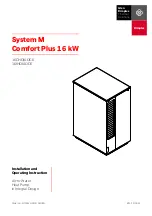
Page 8
XP14 SERIES
STEP 2 -- REFRIGERANT PIPING -- Installing Indoor Expansion Valve
This outdoor unit is designed for use in systems that include an expansion valve metering device (purchased separately)
at the indoor coil. See the
XP14 Product Specifications bulletin (EHB)
for approved expansion valve kit match-ups and
application information. The check expansion valve unit can be installed internal or external to the indoor coil. In applica
tions where an uncased coil is being installed in a field-provided plenum, install the check/expansion valve in a manner
that will provide access for future field service of the expansion valve. Refer to below illustration for reference during
installation of expansion valve unit.
1 -
Attach the vapor line sensing bulb in the proper
orientation as illustrated to the right using the clamp and
screws provided.
NOTE
- Though it is preferred to have the sensing bulb
installed on a horizontal run of the vapor line, installation
on a vertical run of piping is acceptable if necessary.
NOTE
- Confirm proper thermal contact between vapor
line and check/expansion bulb before insulating the
sensing bulb once installed.
2 -
Connect the equalizer line from the check expansion
valve to the equalizer vapor port on the vapor line. Finger
tighten the flare nut plus 1/8 turn (7 ft-lbs) as illustrated
below.
TWO PIECE
PATCH PLATE
(UNCASED
COIL ONLY)
VAPOR
LINE
LIQUID LINE
ORIFICE
HOUSING
DISTRIBUTOR
TUBES
LIQUID LINE
MALE EQUALIZER LINE
FITTING (SEE
EQUALIZER LINE
INSTALLATION FOR
FURTHER DETAILS)
SENSING
LINE
EQUALIZER
LINE
CHECK
EXPANSION
VALVE
TEFLON
®
RING
(Uncased Coil Shown)
Sensing bulb insulation is required if
mounted external to the coil casing. sensing
bulb installation for bulb positioning.
STUB
END
TEFLON
®
RING
LIQUID LINE
ASSEMBLY WITH
BRASS NUT
DISTRIBUTOR
ASSEMBLY
3 -
Install one of the provided Teflon
®
rings around the
stubbed end of the check expansion valve and lightly
lubricate the connector threads and expose surface of
the Teflon
®
ring with refrigerant oil.
4 -
Attach the stubbed end of the check expansion valve to
the liquid line orifice housing. Finger tighten and use an
appropriately sized wrench to turn an additional 1/2 turn
clockwise as illustrated in the figure above, or tighten to
20 ft-lb.
5 -
Place the remaining Teflon
®
washer around the other
end of the check expansion valve. Lightly lubricate
connector threads and expose surface of the Teflon
®
ring with refrigerant oil.
6 -
Attach the liquid line assembly to the check expansion
valve. Finger tighten and use an appropriately sized
wrench to turn an additional 1/2 turn clockwise as
illustrated in the figure above or tighten to 20 ft-lb.
ON 7/8” AND LARGER LINES,
MOUNT SENSING BULB AT
EITHER THE 4 OR 8 O'CLOCK
POSITION.
12
ON LINES SMALLER THAN
7/8”, MOUNT SENSING
BULB AT EITHER THE 3 OR
9 O'CLOCK POSITION.
12
BULB
VAPOR LINE
VAPOR LINE
NOTE -
NEVER MOUNT THE SENSING BULB ON
BOTTOM OF LINE.
BULB
BULB
BULB
VAPOR LINE
FLARE NUT
COPPER FLARE
SEAL BONNET
MALE BRASS EQUALIZER
LINE FITTING
FLARE SEAL CAP
OR
1
2
3
4
5
6
7
8
9
10
11 12
1/2 Turn
SENSING BULB INSTALLATION
EQUALIZER LINE INSTALLATION
1
2
3
4
5
6
7
8
9
10
11 12
1/8 Turn
1 -
Remove and discard either the flare seal cap or flare nut
with copper flare seal bonnet from the equalizer line port
on the vapor line as illustrated in the figure below.
2 -
Remove the field-provided fitting that temporarily recon
nected the liquid line to the indoor unit's distributor as
sembly.
INDOOR EXPANSION VALVE INSTALLATION
FIGURE 9




































